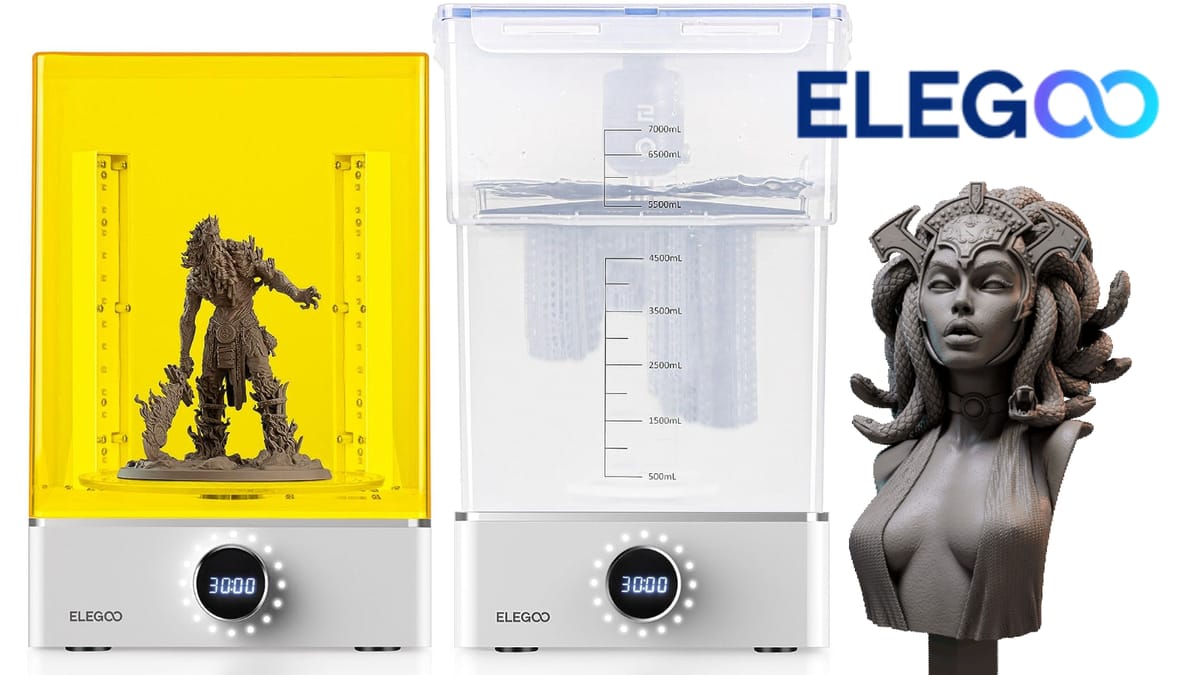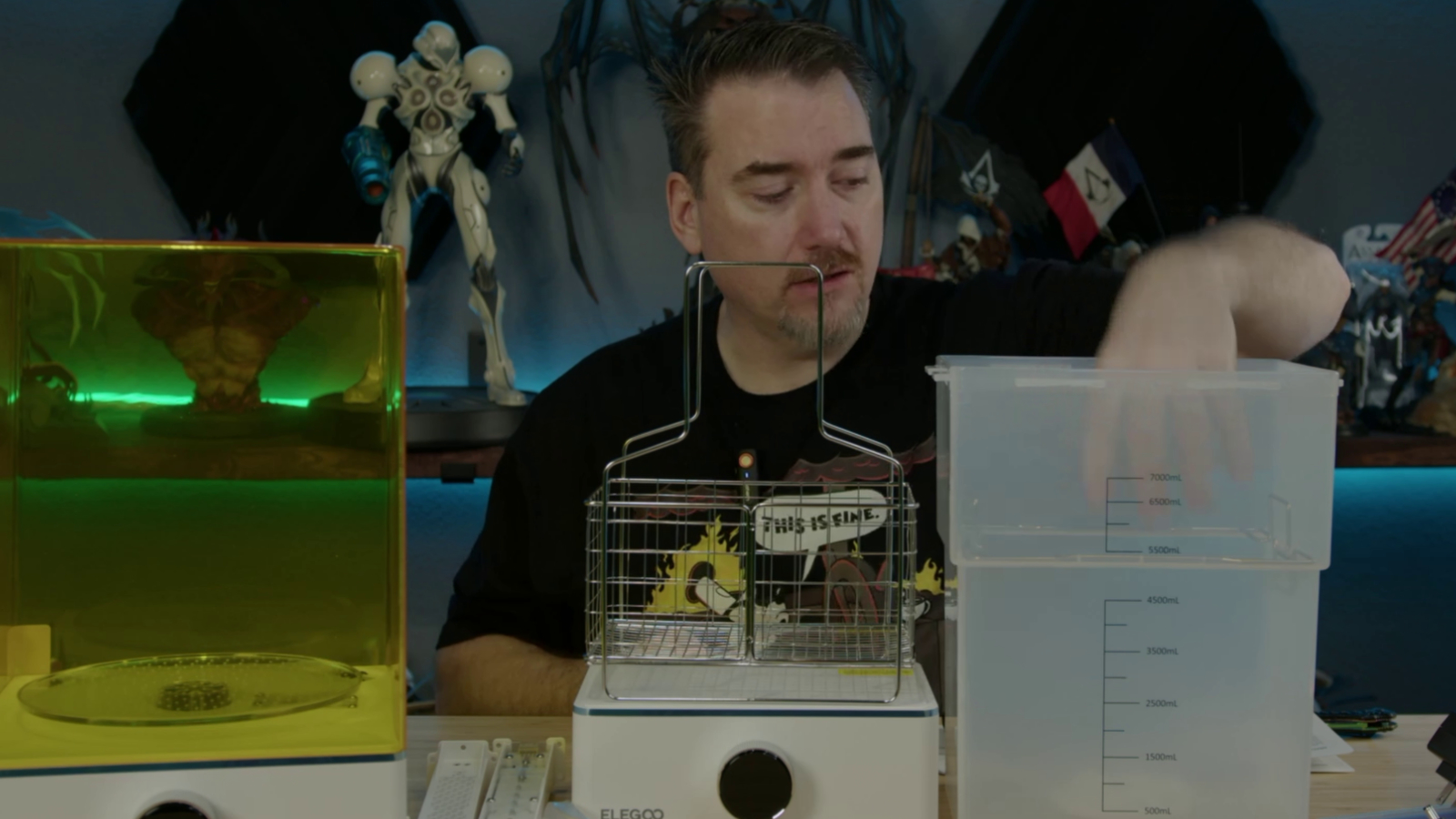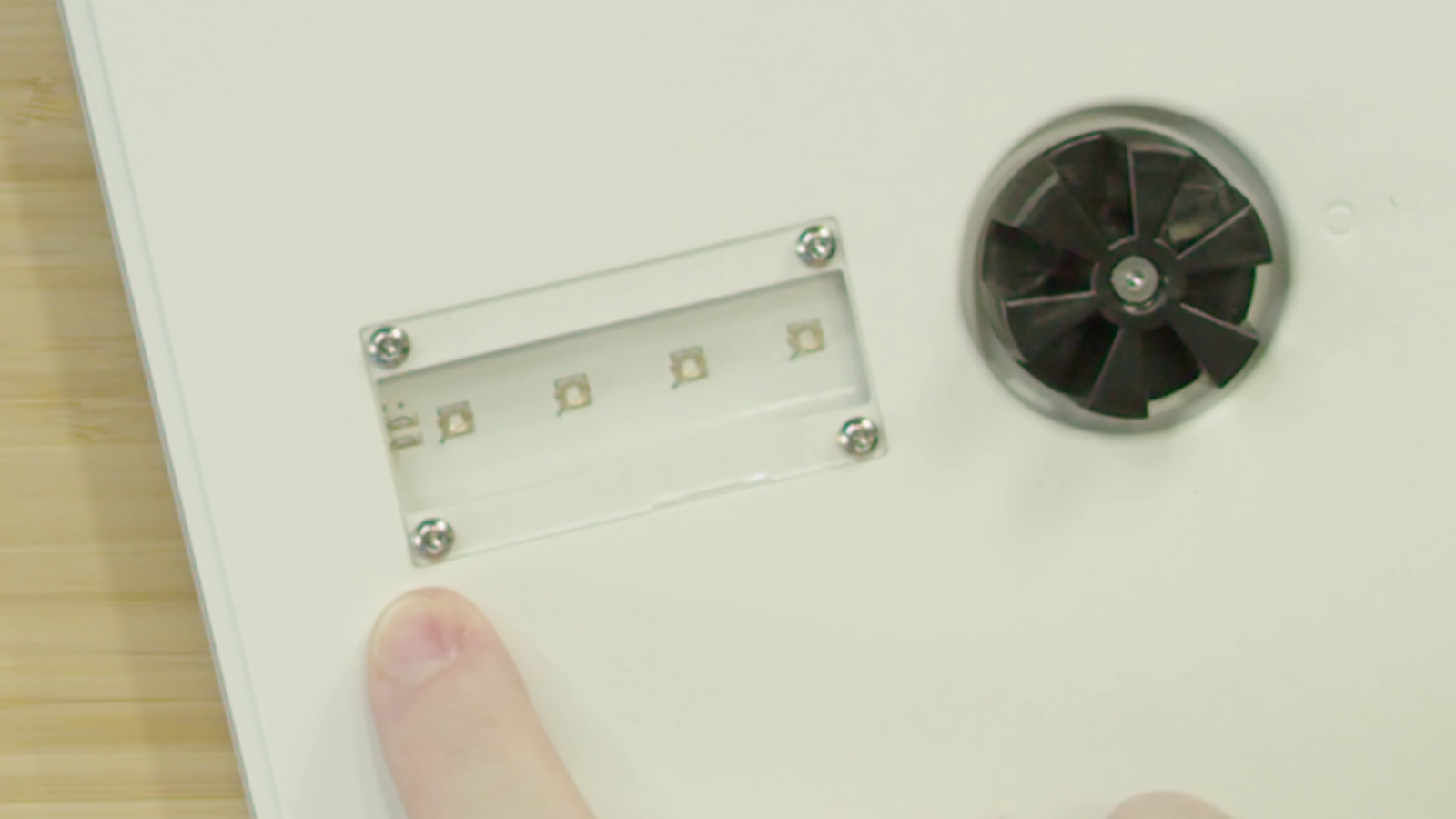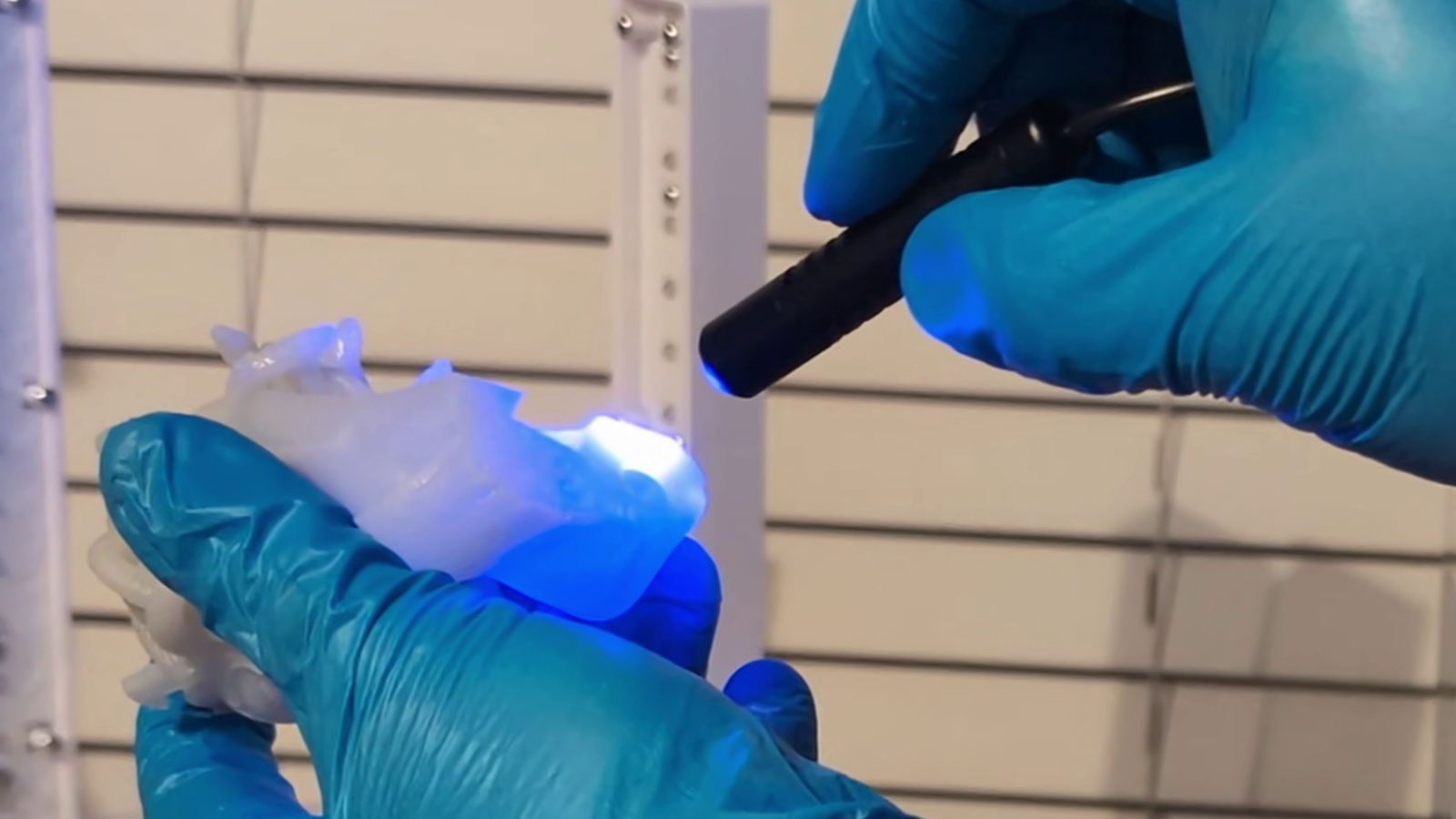
There are a lot of ways to wash your prints once they’re complete. I’ve seen people fill a spray bottle with IPA, douse the print, and then towel them off with a microfiber cloth. Other folks use an ultrasonic bath you’d normally use for jewelry. It’s also possible to use a dunk and wash method, using a 5 gallon bucket and IPA. The problem with all of these options is that they are messy. Wash and Cure combo stations are becoming the norm, and although Elegoo sells a combination where you can remove the spinning cure plate and swap in a wash bucket, they’ve also separated them out for this product. Why would somebody want two separate stations? Well, let’s take a look at the Elegoo XS Bundle and find out.
I’ll be up front – I already own a wash/cure station, and from Elegoo’s competitor, Anycubic. I picked it up when I first started printing, and it’s served me pretty well, albeit with some drawbacks that I’ve found over time. But I’m getting ahead of myself. Let’s unbox this pair from Elegoo and see what’s going on with the Elegoo XS.
Inside the box you’ll find the base for the two stations, the cleaning container for the wash station, the wash basket (in two parts), the anti-UV lid, the curing lights that you’ll attach to the curing station (naturally), a wrench and screws you’ll use to attach said lights, a handheld UV lamp, a set of UV protective glasses, the manual, and finally the power adapter. We’ll get back to the latter when we talk setup. As I mentioned, the stations are separated – one for cleaning, and another for curing, so let’s start with the former and then check out the latter.
The wash station measures 255mm (10.03″) wide by 155mm (6.1″) deep, with a height of 385.5mm (15.17″). There are two stages to the bucket, with a slightly larger portion near the top. The basket that goes inside the bucket is split into two parts — a small basket and a larger one with handles on it. The smaller basket can rest in the inner lip of the wash bucket, with the larger of the two falling all the way to the bottom. Why? Well, you have a new way of washing your prints — on the plate itself. Using this basket adapter, you can leave the print on the plate, washing it in place. Normally I wouldn’t leave an object still attached to the plate, but for larger prints that perhaps have a separate base, this is a great feature. You can leave the item on the plate, ensuring it stays secure and doesn’t bounce around in the vortex of the liquid spinning, keeping delicate parts safe.
Speaking of the vortex, the cleaning function spins the IPA in both directions. It’ll run for a minute in one direction, cycles down, and then spins back in the other direction. It does this for every minute you spend washing. This helps clean the print, but also helps hit some of the harder to reach nooks and crannies in your print. The basin can hold up to 7000ml, though you may or may not use that much IPA at once, depending on the size of your prints. 7000ml is enough to handle a print over a foot tall as a single piece, though it’s just as likely that you’ll be printing a number of smaller parts and washing them as a batch. If you did remove the items from the plate, you’ll use the basket to lift them out of the IPA. If you are setting the plate directly on the secondary basket, then you’ll pull the plate and then remove the print – just make sure you clean the contact surface once you do as it’ll still have resin on it. If you are curious, yes – it will fit plates from other manufacturers, as long as they are roughly the same size as a Saturn 3.

I didn’t expect to be impressed with the cleaning capabilities of a wash and cure station, but I do actually see a difference between my Anycubic and this Elegoo XS model. Perhaps the magnetic wheel underneath is creating more turbidity with faster spins, I can’t be sure, but I’ve found that I’m getting far less shiny or sticky prints after a two minute wash. Proof is in the pudding, I suppose.
In practice, you’ll want to pick up a second bucket. The first wash on a print is usually a massive cloud of shed resin. The two bucket method allows you to have one that’s going to wash away the bulk of the surface coat, and then you can transfer it to your second wash where the last bit of washing occurs. You wash until the first bucket is too contaminated, then you make bucket two into bucket one. You then cycle out that first bucket’s IPA, curing it and optionally allowing it to settle out for re-use.
The cure station has a pair of towers you’ll attach to the rear corners of the cure base with the included wrench and screws. These towers have a prismatic lens on them to help spread the light from the 14 UV LEDs on each side evenly across the print, operating at 405nm. On the bottom of the base is another set of 4 UV LEDs shining upwards into the underside of your print to cure inside. The clear plastic plate rotates around to give a 360 degree spin through the UV light to ensure the entire model is cured and safe.

Both of these devices operate off of a single power brick, with a Y pigtail sending power to both base stations. They both operate with a single knob in the front of each base. Holding the center in for a moment turns on the machine, and then spinning the outer wheel sets the time for cleaning or curing in 30 second increments. Each model will require longer or shorter wash and cure times, so you’ll have to experiment with those times to figure out how much time is needed for each type of resin.
On the side of the cure station is a small port. The included UV pen plugs in here, providing a hand held cure light. The eye on it cures at 405nm – the appropriate wavelength to cure resin quickly. Provided you punch a hole large enough for it to fit, you can press this eye inside of a cleaned print, using the device to cure the inside. This is important as uncured resin can continue to “drool” out of the print, or worse crack or even explode. Sure, you can try to make your own version if this pen, but despite my best efforts I was never able to dial in an LED bright enough or at the right wavelength to do what this one can do – it’s a fantastic surprise, and one that I hope continues into future wash/cure stations Elegoo and other vendors sell.

Included in the box is a set of UV protective glasses. If you are willing to tinker to disable the safety mechanism (and I don’t recommend this), you could theoretically wear these glasses with the hood off the cure station to watch the device do its work. There’s not really a reason to do so, but it does provide a tacit warning about looking directly at high-powered LEDs. It’s nice to see an included safety appliance like this included.
One of the problems I was trying to solve was the ability to cure larger prints like the ones that come off my Jupiter SE. I still have that problem. The cure station can handle prints 14.3” tall, though the towers end about an inch shorter than that. Larger prints like the Minthara from Baldur’s Gate 3 that I showcased with the Jupiter SE would still require two passes (one right side up, and another upside down) to ensure even curing. Just know that if you scale beyond that 14” height, you’ll run into issues with the vertical limits of the light towers. It’s time for Elegoo to make a Jupiter-sized wash and cure station, or it’s time for me to start splitting up my prints.

The Elegoo team has been great to work with when I’ve needed support, and they stand behind their products. To that end they have a 14 day satisfaction guarantee to ensure you like the device. They also offer lifetime support and a 1 year warranty. At the time of writing, you’ll pick up the pair of these for $179, though I’ve seen them on sale for as low as $120 on occasion.
So why would you want two separate devices? The biggest advantage is that you can run both devices at the same time. If you own multiple 3D printers, you might find yourself having a need to cure and wash simultaneously. Harder resins may require longer time curing, so being able to continue to wash other prints might be a boon. For me it’s simpler than that – I’m keeping liquids away from my resin curing. Looking at my Anycubic after roughly two years of use, the reflective plate is starting to look rather rough. A little splash here and there and suddenly I’m looking at needing to replace the spinning plate and said reflector. Sure, the Elegoo XS fixes the reflector problem by replacing it with four LED pearls in the base, which is a solid improvement over a shiny piece of plastic, but keeping both activities very separate has already improved my workflow. It’s cut my post-work cleanup, and the set-it-and-forget-it nature of a wash and cure station allows me to multitask.
Elegoo XS Bundle Wash and Cure
Excellent
With a large basin, and a refined cure design, the Elegoo XS Bundle improves your workflow and helps produce crisp and clean prints. The added cure pen is a fantastic addition, as is the upgraded washing functionality. It all comes together to make the messy work of 3D printing just a little bit cleaner.
Pros
- Large volume wash basin
- Small cure pen is a great addition
- On-plate wash is a novel approach
- 32 LEDs give an even cure
Cons
- We need a bigger solution
